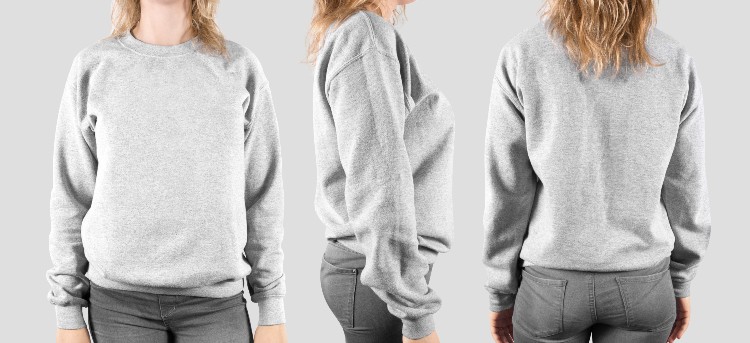Hoodie or sweatshirt, which one should I wear? With the nights starting to draw in, I need a pullover to keep me warm. But which one is best? Should I wear a hoodie or a sweatshirt? What’s the difference?
The main difference between a hoodie and a sweatshirt is the style. A sweatshirt is a plain, crewneck pullover made from a knit fabric like French Terry. Sweatshirts do not have zippers or buttons. In contrast, a hoodie is a hooded sweatshirt. Hoodies have large front kangaroo pockets and can be fastened with zippers.
In this article, you’ll learn how sweatshirts and hoodies differ. Discover how to style them and what events they are best suited to.

Quick Navigation
Hoodie vs Sweatshirt: Key Points
Hoodies and sweatshirts are very similar garments. They are practically siblings in the world of fashion. Not only are they made from the same fabric, but they can also be styled in nearly identical ways.
They have the same origins too. Both garments were used as cover-ups following exercise to prevent an athlete from cooling down too quickly. The fabric they were made from would soak up the sweat and wick it away from the skin, helping the sportsperson regain control of their body temperature.
Despite their comparable appearance, there are some major differences between the two. Their necklines differ considerably, as does the image portrayed by each style of these popular pullovers.
The following table compares the main characteristics of hoodies and sweatshirts against each other. Having their key points side-by-side will help you identify their pros and cons. That way, you’ll be able to tell if a hoodie or a sweatshirt is the right garment for you and your style.
| Hoodie | Sweatshirt | |
|---|---|---|
| Appearance | Pullover with a drawstring hood Standard or raglan sleeves Close or loose fitting silhouette | Pullover with a crewneck neckline Standard or raglan sleeves Loose fitting silhouette |
| Collar | Has an integral hood rather than a specific collar | Traditionally a round, flat, stretchy neckline that sits at the base of the neck Modern styles can include a small stand-up collar similar to the Mandarin style |
| Fabric | Sweatshirt knit, Jersey knit, French terry, fleece, cotton lycra, | Sweatshirt knit, jersey knit, French terry, fleece |
| Fastenings | Can have zippers down the length of the front Drawstrings on the hood | Can have small zippers at neckline area |
| Pockets | Large front kangaroo pocket | Sometimes have in-seam pockets |
| Reputation | Rebellious and mysterious Youthful mischief | Active and energetic more business-like |
| Uses | Cover-up after sporting activities Cold weather wear Casual events | Cover-up after sporting activities Cold weather wear Smart/casual events |
What Is a Sweatshirt?

A sweatshirt is a type of pullover with a crewneck style neckline, long sleeves, and ribbing at the cuffs and waistline. The sleeve shape can vary between standard and a raglan style, depending on the sweatshirt design.
Sweatshirts were originally part of sporting apparel. Athletes would wear them as part of a tracksuit to cover up before and after exercise. They could also be worn before the start of competitions and sporting events. Part of their appeal was the freedom of movement they offered.
Not only did they keep the athlete cozy while they waited for their event to start, but they also helped them to warm up. A sweatshirt’s easy, loose-fitting nature allowed athletes to do their pre-event limbering-up routine without stripping down to a t-shirt and shorts. So instead of having to do stretching exercises in the cold, the athlete’s muscles were already warm and ready for action.
Better still, sweatshirts and their coordinating pants helped athletes cool down afterward. By absorbing sweat, these super soft garments gave athletes a chance to regain control of their body temperature at a sedate pace. Rather than sweat evaporating to leave the athlete feeling chilly.
Made from a soft cotton fabric that was smooth on the outside and fluffy on the inside, they were incredibly comfortable. The fabric was a type of terry knit or French terry. These days, we know it as sweatshirt knit too!
It didn’t take long for the general population to catch on to the benefits of clothing made from sweatshirt knit fabric. Sweatshirts and sweatpants soon became the mainstays of modern, casual fashion.
Traditional sweatshirts don’t usually have fastenings like zippers and buttons. They are a pullover which means you pull them over your head. The crewneck neckline is a flat piece of stretchy ribbing that gives just enough to allow your head through.
Some modern styles of sweatshirts, particularly designer shirts, have stand-up collars that form part of a partial zipper opening. The opening isn’t very large and the zipper only extends to the upper chest area. The collar is basic, short, and reminiscent of a Mandarin design.
Modern sweatshirts have come on a long way from their sporting days. They fit the smart-casual category of clothing. Suitable for work and play, they can be worn for construction, office work, and relaxing days out on your boat.
Wear a dark-colored crewneck sweatshirt over a dress shirt. Pair it with chinos and loafers, and you have smart office attire. Wear a traditional gray sweatshirt with jeans and sneakers for a casual look.
What Is a Hoodie?

A hoodie is essentially a sweatshirt in disguise. The word hoodie is short for hooded and can potentially refer to any garment with a hood,, whether jackets or sweatshirts.
However, because the word was originally coined to describe a hooded sweatshirt, a hoodie is understood by most people to be a sweatshirt with a hood.
Hoodies are the next step in the sweatshirt story. They are an improved design if you like. The sweatshirt-style garments keep your upper body warm, and now you have a hood to cover your head and ears. When your head’s warm, the rest of your upper body feels super toasty. Just what you need for those cold winter walks in the park.
Made from the same soft sweatshirt knit or terry fabric, a hoodie shares many of the characteristics sweatshirts are famous for. The same fluffy inside, smooth exterior and loose-fitting style give you plenty of room to move.
However, there is more to a hoodie than being a sweatshirt look alike. Over time, they have developed their own identity. They can be made from French terry, jersey knit, and fleece, just like a sweatshirt. But, they can also be made from fabrics like cotton lycra, giving them a closer-fitting silhouette and a lightweight feel.
Meaning hoodies aren’t just winter garments. Depending on the fabric, you can get a hoodie perfect for those cooler summer evenings. Unfortunately, this doesn’t mean you can wear a hoodie everywhere. They come with a bit of a dark side.
Although sweatshirts are widely accepted as suitable garments for various activities, the same isn’t true for hoodies. Hoodies have a relaxed, laid-back persona and are great casual items. But they have a bit of a reputation for being worn by troublemakers.
As the garment has a hood that can cover the face, hoodies are seen to be a dress code for those wishing to keep their identity hidden. Due to its popularity with younger generations, the hoodie is associated with youthful rebellion and teenage angst.
In many parts of the world, the hoodie became synonymous with gangs loitering on street corners. It became such a symbol of misbehavior and evil intent that people wearing hoodies could find themselves banned from entering public places like shopping malls.
Because of this reputation, hoodies are not considered suitable garments for formal or smart occasions. They are only wearable as loungewear or for dress-down days at work. Casual relaxation is the image given off by the hoodie.
Hoodies look great styled with jeans or chinos, but don’t be tempted to wear a button-down shirt. The shirt collar will clash with the hoodie aesthetic. One thing you can’t do with a hoodie is worn it to a formal event.
What’s the Difference Between Hoodie and Sweatshirt?

The main difference between a hoodie and a sweatshirt is one has a hood and the other doesn’t. While it’s true hoodies can be sweatshirts, a sweatshirt can never be a hoodie. Simply because to be a sweatshirt, it can’t have a hood.
Even so, hoodies don’t necessarily have to be sweatshirts. To be a sweatshirt, they have to be made from the same fabric. That isn’t always the case. Hoodies can be made from stretchy fabric like cotton lycra to make them more close-fitting, which doesn’t fit the sweatshirt aesthetic.
With so many similarities and differences, it can be tricky to know a sweatshirt from a hoodie at first glance. Let’s take a look at some common characteristics side-by-side.
Appearance
The appearance of a hoodie and a sweatshirt can be very similar, particularly if they are both made from a sweatshirt knit or French terry.
Although hoodies and sweatshirts can be found in many different colors, the most famous shade is gray. Both garments are usually plain and free from any patterning in the fabric. They are normally one solid color, but you can find them with a color-block effect. This is where more than one solid color is used to create a two-tone design, usually across the top of the chest.
You may even find the sleeves are in a contrasting or coordinating color from the main body of the garment. This style is particularly effective when the sweatshirt or hoodie has raglan sleeves.
Sweatshirts and hoodies are both loose-fitting garments offering you plenty of freedom to move. They have ribbed cuffs to pull the sleeves in close to the wrist. This helps keep cold air out and away from your arms.
Similarly, the waistband is also made of ribbing, giving hoodies and sweatshirts their signature look of being pulled in at the hips.
Hoodies and sweatshirts can also look very different from each other. A hoodie can be made from thinner materials. Cotton lycra can give hoodies a slimline silhouette that is almost figure-hugging. That is a major difference between the two. Sweatshirts are always loose-fitting, while hoodies can be designed to be loose or tight-fitting.
Then there is the obvious difference. A sweatshirt has a crewneck and a hoodie has a hood. Crewnecks are flat necklines that sit on the base of your neck. Usually made from ribbing, they stretch to allow you to pull the sweatshirt over your head.
Hoods, on the other hand, remove the need for a neckline. Attaching the hood hides the raw edges of the main body of the garment. The hood has an opening, so the neck area is loose enough to fit around your head. The addition of drawstrings allows the sides of the hood to be pulled in to close the gap.
Collar
Neither hoodies nor sweatshirts are known for having collars. As previously mentioned, hoodies have hoods and sweatshirts have a crewneck. But, considering them both to be collar-free isn’t necessarily accurate.
Originally, collars were a protective barrier to separate the neck from scratchy or rough outer garments like wool coats. Because of this, collars would stand proud against the neck area.
There are many different forms of collars. From the shirt style to the Mandarin. But many of them have some form of the collar stand. That’s the bit that stands up and gives the collar its structured shape and link with the traditional collar function.
There are a few exceptions to this. The cowl, the cascade, and the crewneck are just a few of them. Although we don’t always think of a crewneck as anything other than a neckline finish, it is, in fact, a collar.
The modern definition of a collar differs from its historical origins. These days a collar is seen as a way of finishing off a neckline to hide the raw edges of a garment.
Sweatshirts are famous for their crewneck design, but they can also have another style of the collar. In modern sweatshirts, there are sometimes zipper fastenings at the neckline. These usually go from the top of the collar to the top of the chest.
When the zipper is undone, the neckline lies open similarly to a wing collar. Do the zipper up to the top, and you get a similar look to a Mandarin collar or a turtle neck.
A hood is slightly different. Although sewing a hood onto the neckline of a sweatshirt does tidy up raw edges, it can’t be classed as a collar. The reason is that the hood extends beyond the neck and over the top of your head. To be a collar, it would need to sit at the neck.
This means that hoodies don’t have collars. Although you may find one with a separate collar inside the hood, these are rare. It is the norm for hoodies to just have hoods.
Fabric
Sweatshirts and hoodies are made from knit fabrics, giving both garments a looser, easy-fit structure that is roomy and comfortable.
The most popular material for sweatshirts is French terry. It’s a two-sided material, with one side completely smooth and the other tufted or fluffy. The tufts are created by loops of the yarn and give a fleece-like feel to the fabric.
Traditionally made out of 100% cotton, French terry can contain other fibers like spandex to create a more flexible garment. It’s often mistaken for fleece, another popular choice for loungewear like sweatshirts and hoodies.
Where fleece differs is it tends to be synthetic rather than a natural fabric. Sweatshirts and hoodies made from fleece tend to be less breathable, but they still have the same fuzzy touch on the inside. You’ll sometimes find fleece called sweatshirt fleece due to its close association with the clothing.
Other knits you can use for sweatshirts include jersey knits. These are particularly popular for making hoodies. Jersey knits can be lighter than French terry cloth. Because of this, jersey fabrics get used for making t-shirts and the more figure-hugging hoodie styles.
Fastenings
Sweatshirts are designed to be pulled over the head. They are made from a stretchy knit fabric and do not require any form of fastening. A traditional sweatshirt does not need zippers or buttons.
Modern designs of sweatshirts do have some fastening devices. Some sweatshirts have small zippers in the center front. Only going from the top of the collar to the top of the chest, these smaller fasteners are a design element to give sweatshirts a hint of sophistication.
They can also have zipped in-seam pockets. But that’s pretty much it. The appeal of a sweatshirt is its easy-on, easy-off nature. Simply drop it over your head and go.
Hoodies, on the other hand, can have zippers and drawstrings. The zippers turn the hoodie from a pullover into a cardigan-style garment. Running the length of the center front, the zippers stretch from neckline to hemline.
Drawstrings are an integral part of the design of many a hoodie. They are used to draw the sides of the hood together to make it fit snugly around your head. Either tied or held together by toggles, these hood fasteners keep wind and rain at bay and your head dry and warm.
Pockets
Pockets are the one area where sweatshirts and hoodies differ a lot. Their pocket style speaks volumes about their perceived suitability for many activities.
Hoodies have their trademark kangaroo pocket. This large pocket spans the width of the garment from side seam to side seam, even on cardigan-style hoodies. A zipper may split the center of the garment, but the kangaroo pocket is visible on both sides, creating an evenly sized front pocket on each.
Sweatshirts don’t always have pockets. When they do, they are more likely to be hidden in the side seams. This type of pocket is known as an in-seam pocket and they are designed to be practically invisible or unobtrusive.
The difference in pocket style between hoodies and sweatshirts determines where they can be worn. A kangaroo pocket is quite laid back and slouchy. It gives the hoodie the same persona. This means hoodies are thought to be too relaxed for formal events. Even wearing one to the office can get you some disapproving looks.
Sweatshirts, particularly in darker shades like black, brown, or navy blue, look like smart sweaters. With hidden in-seam pockets, nothing is visible to detract from the feeling of professionalism.
They are acceptable in business settings because they look the part. Wearing a sweatshirt instead of a hoodie will help you look competent and efficient.
Reputation
Whether it’s fair or not, the poor old hoodie has earned some bad press over the years. Its reputation has been severely tarnished due to its perceived connection with questionable behavior, particularly among youths.
Hoodies have oversized hoods which not only cover the head but they also obscure facial features. Seen by many as a way to hide identities, hoodies became the disguise of those with criminal intent. Hoodie-wearing teenagers were labeled as yobs. Loitering and up to no good, these youngsters were branded as troublemakers and miscreants.
In reality, they were probably just bored with nothing to do. But, the fear and distrust the hood-covered groups installed in the general populace led to hoodies being linked to violence and rebellion. It’s a reputation the hoodie has found hard to dispel.
In contrast, the sweatshirt doesn’t convey the same image. Instead, it is readily accepted as a garment that anyone can wear, regardless of age. It has a fresh, modern feel and oozes energy and enthusiasm.
The difference between how you will be treated wearing a hoodie or a sweatshirt couldn’t be starker. In a hoodie, you will be met with suspicion, especially if you are from the younger generation. Wear a sweatshirt and you’ll be taken seriously.
Uses
Due to the hoodie’s negative vibes, their uses are a little limited. They are and probably always will be casual garment. Meant for your downtime or weekends. Although they look fantastic teamed with jeans and sneakers, they don’t quite make the mark when worn with suit pants.
It isn’t just down to the size of the kangaroo pocket either. While the style of pocket is slouchy, how people think about hoodies makes them unacceptable for anywhere except the pub, the park, or the gym.
It doesn’t matter what color you go for with hoodies. They are always going to look slouchy. Ideal for outside work or warming up at the track, keep your hoodie away from formal occasions.
Sweatshirts also look great with jeans and sneakers, but they also look at home with chinos and smart shoes. The styling is classic, and the silhouette is smart-casual. The sweatshirt can take you from the office to a night on the town. Pick dark colors for a business environment and pastels for a more relaxed situation.
They can also be worn on construction sites or at the gym. You can wear a sweatshirt wherever you wear a hoodie, making the sweatshirt the more versatile of the two.
Conclusion
Hoodies and sweatshirts are similar garments. Both are easy to wear, comfortable, and warm in cold weather. Hoodies portray an image of chilled relaxation, while sweatshirts are full of energy and enthusiasm. Which one you decide to wear is up to you and the event you have in mind.
Do you prefer hoodies or sweatshirts? Do you think hoodies get a bad rap? Let me know in the comments.